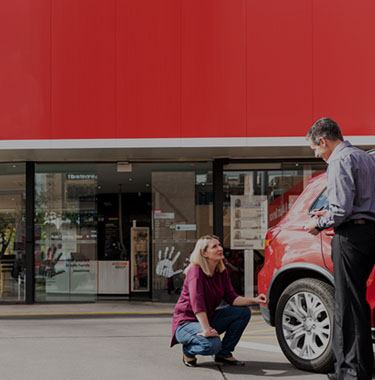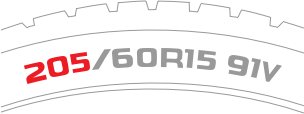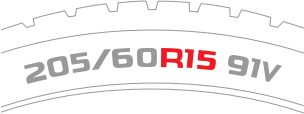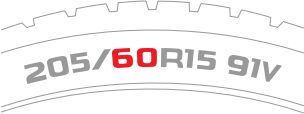Tyre Sizes Explained
Learn to understand your tyre size
Tyre markings explained
Have you ever wondered what the markings on the sidewall of your tyre mean? Your tyre’s sidewall markings are a tyre specification guide containing important information about size, load, and much more. This indicates the nominated tyre size for your vehicle from the manufacturer. Be careful if changing away from the nominated tyre size, as this could make your vehicle un-roadworthy. Learn how to read tyre codes below.
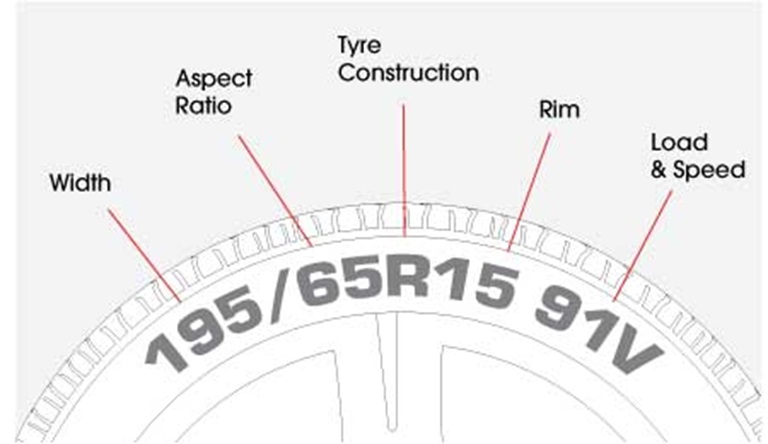
Understanding tyre sizes
Understanding tyre sizes is essential for ensuring optimal vehicle performance and safety. By deciphering the numbers and letters on your tyres, you can make informed choices that enhance handling, fuel efficiency, and overall driving experience.
Width:
The section width of your tyre in millimetres, from the inner sidewall to the outer sidewall. Example: 195mm
Aspect Ratio:
The height of your tyre from the base of the tread to the rim, as a percentage of the tread width. Low profile tyres have smaller aspect ratios. Example: The height of this tyre is 65% of its width.
Tyre Construction:
The method used to construct your tyre. Example: R, for radial ply construction. This is the most common method of construction for passenger tyres.
Rim:
The diameter of the wheel rim in inches. If you are buying wheels for existing tyres, this is the size you will need. Example: 15 inches.
Load Index and Speed Symbol
The maximum load capacity under which your tyre can safely operate, and at what speed. This is subject to the tyre being in sound condition, correctly fitted, and with the recommended inflation pressure. Example: 91 V
Find your tyres
-
Search by size
-
Search by rego
Vehicle data is provided by DriveRight, tyre sizes are a guide only. Tyre sizes can vary, even on similar vehicles.
We recommend you inspect and check your tyre size. Learn how here.
Tyre speed symbol table
| Speed Symbol | Rating (Km/h) |
| E | 70 |
| F | 80 |
| G | 90 |
| J | 100 |
| K | 110 |
| L | 120 |
| M | 130 |
| N | 140 |
| P | 150 |
| Q | 160 |
| R | 170 |
| S | 180 |
| T | 190 |
| U | 200 |
| H | 210 |
| V | 240 |
| W | 270 |
| Y | 300 |
| Z | 240+ |
Tyre load index table
|
Load Index |
Max Load (kg) |
Load Index |
Max Load (kg) |
Load Index |
Max Load (kg) |
Load Index |
Max Load (kg) |
Load Index |
Max Load (kg) |
Load Index |
Max Load (kg) |
|---|---|---|---|---|---|---|---|---|---|---|---|
| 60 | 250 | 85 | 515 | 110 | 1060 | 135 | 2180 | 160 | 4500 | 185 | 9250 |
| 61 | 257 | 86 | 530 | 111 | 1090 | 136 | 2240 | 161 | 4625 | 186 | 9500 |
| 62 | 265 | 87 | 545 | 112 | 1120 | 137 | 2300 | 162 | 4750 | 187 | 9750 |
| 63 | 272 | 88 | 560 | 113 | 1150 | 138 | 2360 | 163 | 4875 | 188 | 10000 |
| 64 | 280 | 89 | 580 | 114 | 1180 | 139 | 2430 | 164 | 5000 | 189 | 10300 |
| 65 | 290 | 90 | 600 | 115 | 1215 | 140 | 2500 | 165 | 5150 | 190 | 10600 |
| 66 | 300 | 91 | 615 | 116 | 1250 | 141 | 2575 | 166 | 5300 | 191 | 10900 |
| 67 | 307 | 92 | 630 | 117 | 1285 | 142 | 2650 | 167 | 5450 | 192 | 11200 |
| 68 | 315 | 93 | 650 | 118 | 1320 | 143 | 2725 | 168 | 5600 | 193 | 11500 |
| 69 | 325 | 94 | 670 | 119 | 1360 | 144 | 2800 | 169 | 5800 | 194 | 11800 |
| 70 | 335 | 95 | 690 | 120 | 1400 | 145 | 2900 | 170 | 6000 | 195 | 12150 |
| 71 | 345 | 96 | 710 | 121 | 1450 | 146 | 3000 | 171 | 6150 | 196 | 12500 |
| 72 | 355 | 97 | 730 | 122 | 1500 | 147 | 3075 | 172 | 6300 | 197 | 12850 |
| 73 | 365 | 98 | 750 | 123 | 1550 | 148 | 3150 | 173 | 6500 | 198 | 13200 |
| 74 | 375 | 99 | 775 | 124 | 1600 | 149 | 3250 | 174 | 6700 | 199 | 13600 |
| 75 | 387 | 100 | 800 | 125 | 1650 | 150 | 3350 | 175 | 6900 | 200 | 14000 |
| 76 | 400 | 101 | 825 | 126 | 1700 | 151 | 3450 | 176 | 7100 | 201 | 14500 |
| 77 | 412 | 102 | 850 | 127 | 1750 | 152 | 3550 | 177 | 7300 | 202 | 15000 |
| 79 | 437 | 104 | 900 | 129 | 1850 | 154 | 3750 | 179 | 7750 | 204 | 16000 |
| 80 | 450 | 105 | 925 | 130 | 1900 | 155 | 3875 | 180 | 8000 | 205 | 16500 |
| 81 | 462 | 106 | 950 | 131 | 1950 | 156 | 4000 | 181 | 8250 | 206 | 17000 |
| 82 | 475 | 107 | 975 | 132 | 2000 | 157 | 4125 | 182 | 8500 | 207 | 17500 |
| 83 | 487 | 108 | 1000 | 133 | 2060 | 158 | 4250 | 183 | 8750 | 208 | 18000 |
| 84 | 500 | 109 | 1030 | 134 | 2120 | 159 | 4375 | 184 | 9000 | 209 | 18500 |
OD:
The overall diameter of your unloaded tyre in mm.
Type Definitions:
An abbreviation providing information about the type of your tyre.
Examples:
RFT – Run Flat Technology
MOE – Mercedes Original Equipment
LRR – Low Rolling Resistance
RBT – Raised Black Letters Tubeless
OWT – Outline White Letters Tubeless
RWT – Raised White Letters Tubeless
LWT – Line White Tubeless
TT – Tube Type
TL – Tubeless
XL – Extra Load
LT – Light Truck construction
N* - Porsche specification
☆ – BMW spec
Our Run-Flat Technology
If your tyre is punctured while driving, you’ll experience loss of tyre pressure that can cause you to lose steering control, endangering yourself and the cars around you. You’ll also face further risk while changing the tyre on the roadside or waiting for mechanics to arrive.When a Run Flat tyre is punctured, there is no sudden deflation. Instead, you can continue to drive safely, despite a total loss of air pressure. Run Flat tyres are built with thicker, reinforced sidewalls, along with heat resistant rubber, to keep the tyre from collapsing so you can continue to a safe location. Tyres with Run Flat Technology should only be fitted to vehicles that are equipped with a Tyre Pressure Monitoring System (TPMS).
Please check with your vehicle manufacturer to see if your vehicle can be fitted with Run Flat tyres.
Frequently asked questions
-
What tyre size should I choose for my car?
We recommend you choose the tyre size identified by your car’s manufacturer on your vehicle tyre placard. Changing your tyre size from the manufacturer’s standard may mean your car is no longer roadworthy, and might not be covered by your insurance. Use our tyre size calculator to find the right tyre size for your vehicle.
-
How do you determine which tyres fit my vehicle?
We use your vehicle’s original tyre size to determine which tyres fit your vehicle. If you use our online tyre size calculator, it’s important that you enter your vehicle’s make, model, and year correctly. You may also search for tyres using your vehicle’s registration or tyre size.
-
What do the numbers on the sidewall of my tyre mean?
The sidewall of your tyre is the part between the edge of the wheel and the tread. If you look closely at the sidewall, you will notice a series of numbers that give you important information about your tyre’s specifications.
